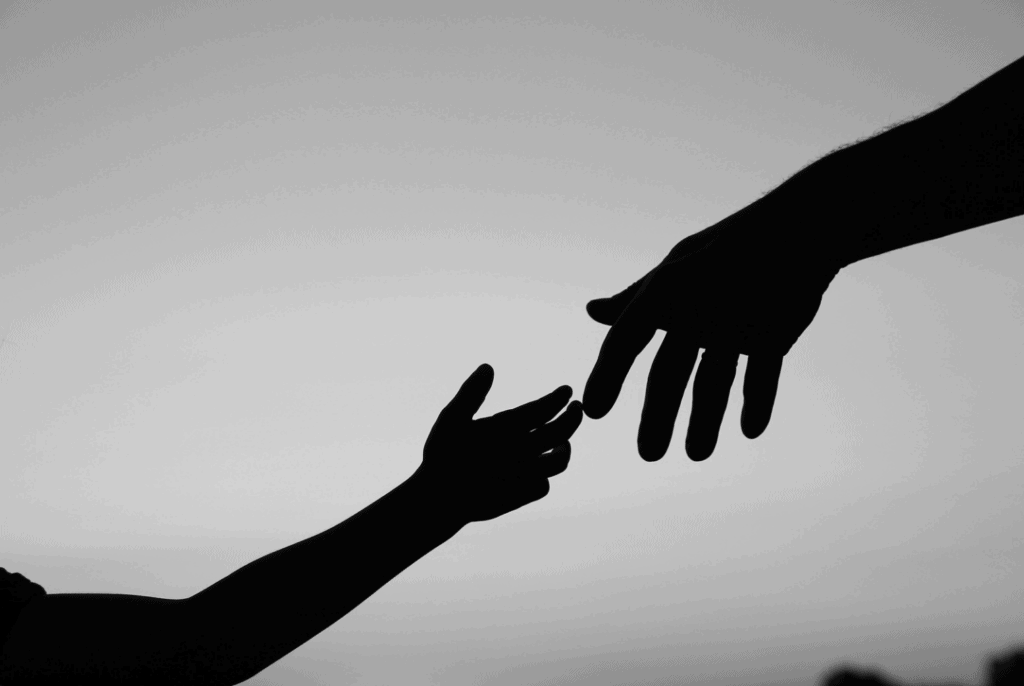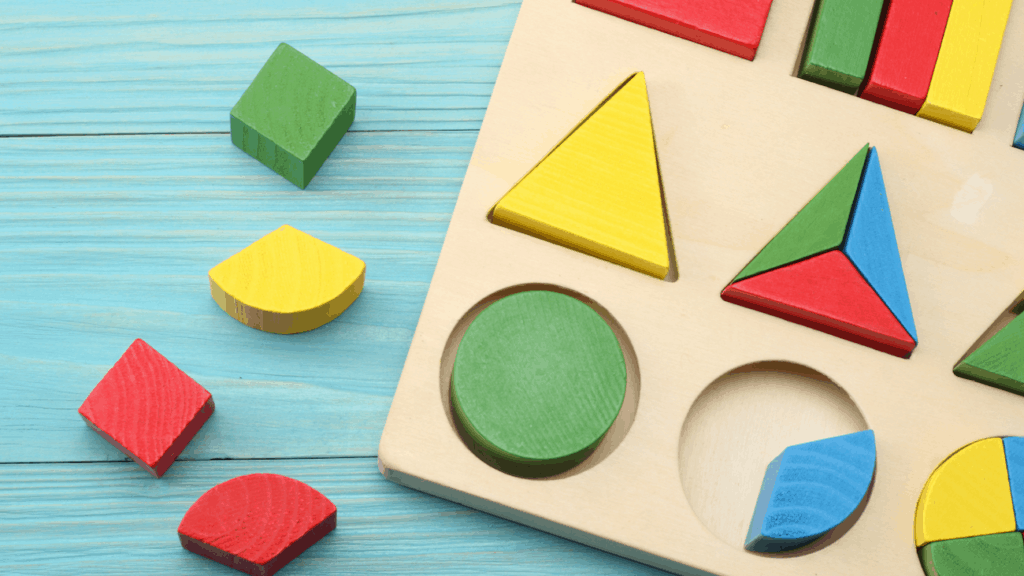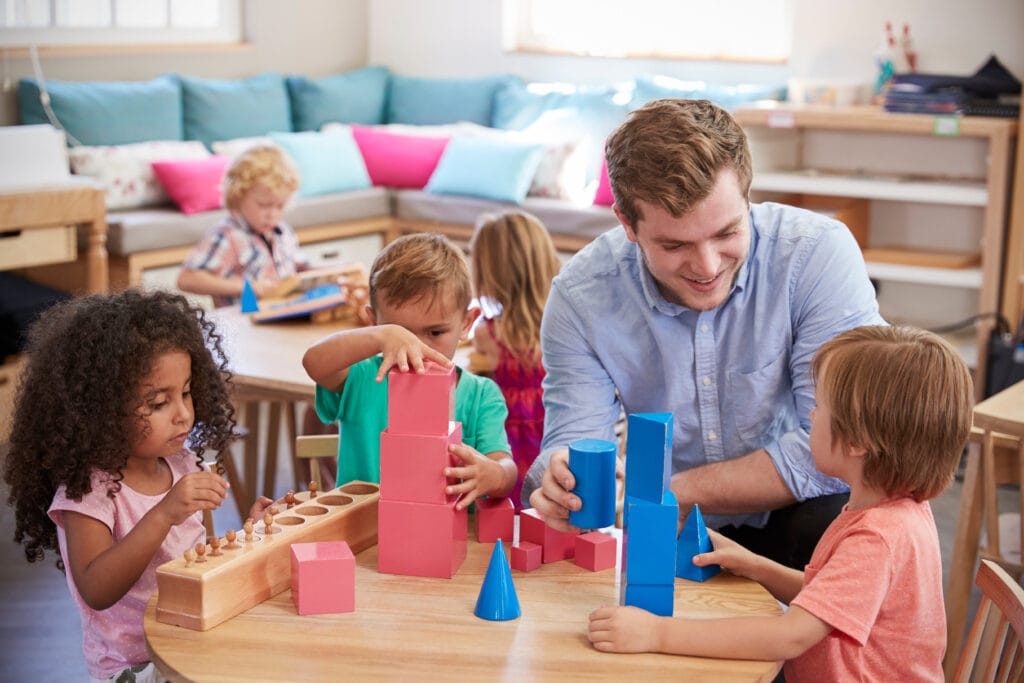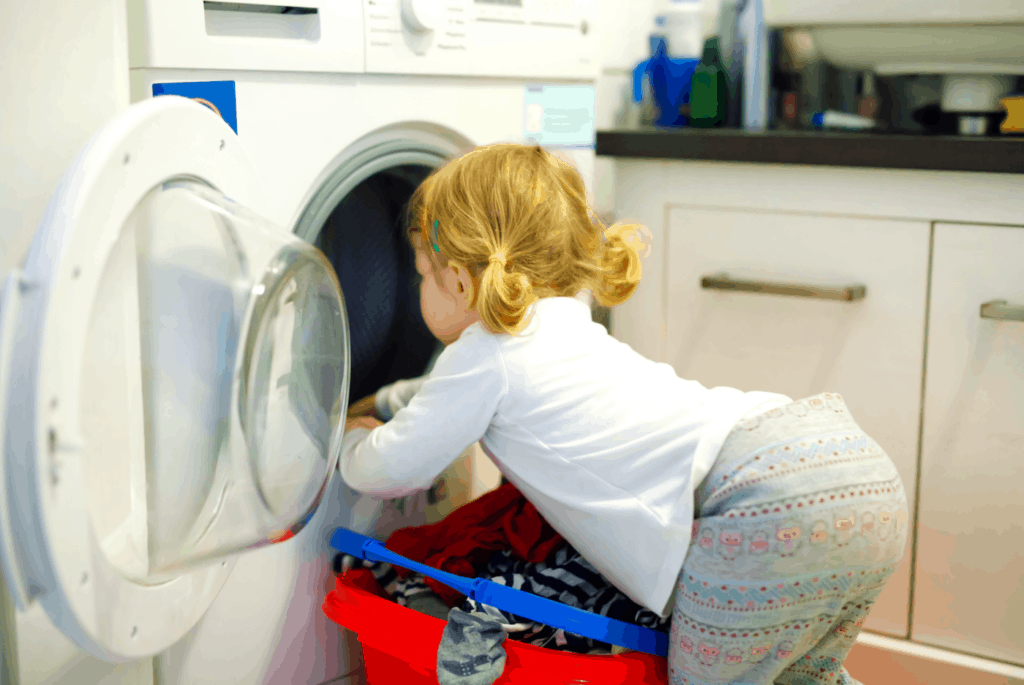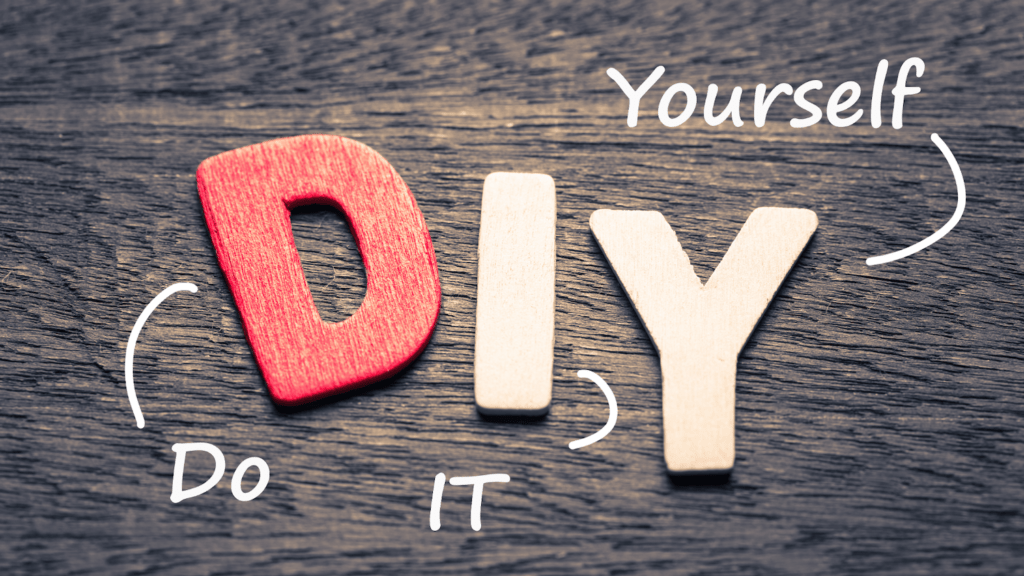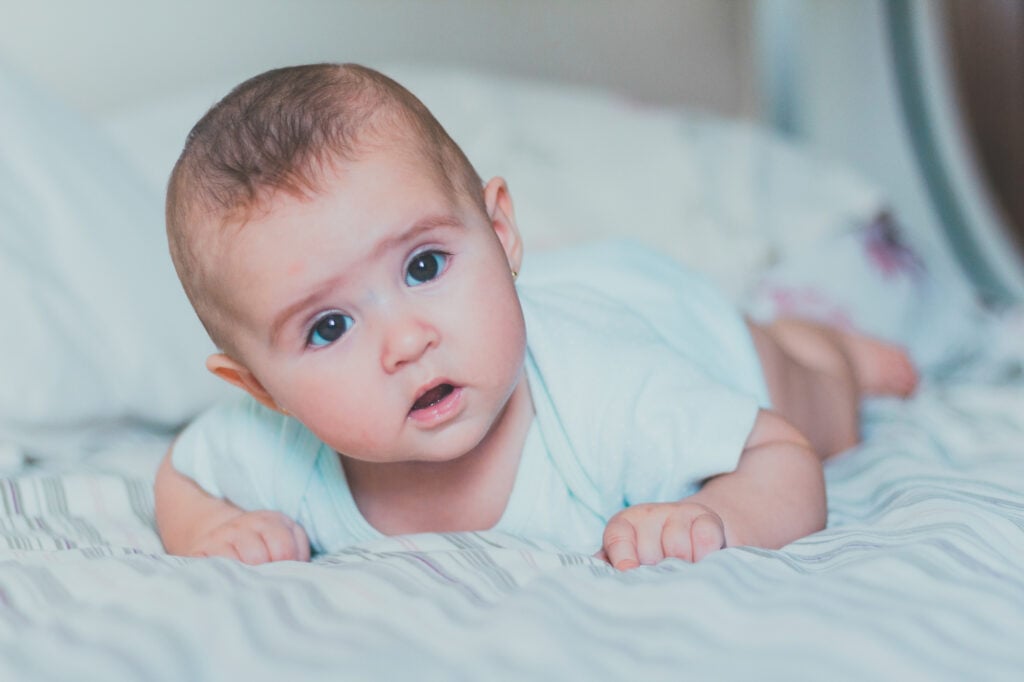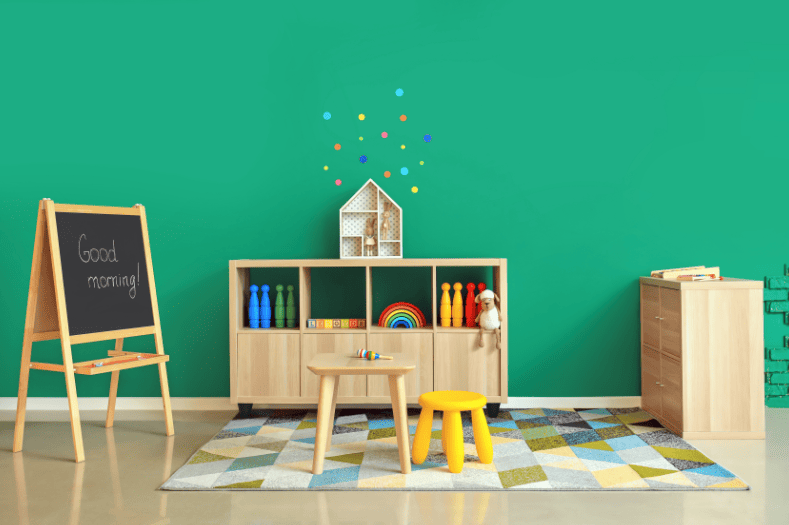
Montessori playrooms are intentionally-designed spaces that optimize children’s opportunities to learn through play. These play spaces prioritize simplicity, function, and accessibility so that children can move about independently and comprehend their options for play without becoming overwhelmed.
Montessori has a reputation for being a little serious. While other child-rearing approaches emphasize fantasy and make-believe,
The
What Makes a Montessori Playroom Different?
Before we start, let’s keep it simple: a
A
“Child-centered experience?” you might be asking yourself. “Isn’t all play child-centered?”
Well, not entirely… A lot of play spaces and experiences for children are designed by adults based on what they think children want. This means loud, overstimulating environments full of colors and sounds and lots of activity. And, sure, these environments can be fun for a while, but they are often overwhelming and fatiguing for most children after even a little bit of time.
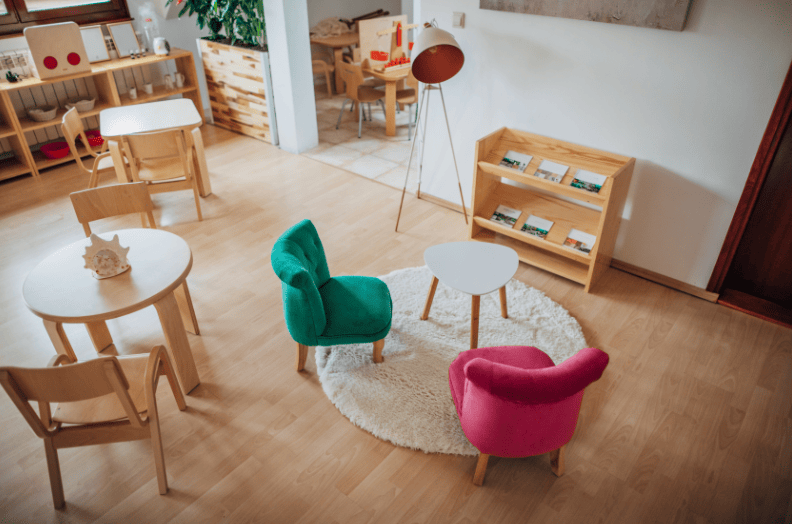
If you’ve ever brought your child to a birthday party at an arcade or similar venue, they were probably overstimulated, exhausted, and irritable by the time you left. This is because children are always in the process of internalizing an immense amount of information about the world around them, so even the smallest sensory experiences feel big to them.
Montessori playrooms, in contrast, attempt to take a child’s-eye view when making design and layout choices. Simplicity, function, and accessibility are the goals to consider when creating a playroom so that children can move through them freely and with full agency and comprehension regarding their options.
Montessori playrooms typically involve child-accessible shelving and toy-storage, a curated selection of clearly-displayed toys, and comfortable places for your child to sit, stand, and move around.
The Dos and Don’ts of a Montessori Playroom
Here are some of the do’s and don’ts of
Do:
- Keep it simple. This applies to color-scheme, layout, activity choices, and furniture.
- Make it cozy! Think about what you can do to make the room feel comforting, inviting, and safe. Soft furniture, blankets and pillows, inviting spaces, cozy little nooks, etc…
- Create a child-focused environment. Everything in the playroom should be easily accessible for your child without adult help. This means child-sized furniture, toys stored in easy-to-reach locations, a completely child-safe and accessible environment, and a space that can be navigated intuitively by children of any age.
- Have a place for everything and everything in its place. Instead of keeping toys jumbled together in one giant toy chest or bin, have them displayed neatly on a child-accessible shelf. (Only store toys that you don’t want your child using.)
- Limit choices. Sometimes having too many options can be overwhelming for children. This can lead to kids claiming “there’s nothing to do!” when they have dozens of toys at their disposal because their brains can’t fully process each toy. Choose 8-10 toys or activities to display in the playroom for your child to choose from and store away the rest out of reach.
- Mix it up! Make sure that the toys you display for your child to use comprise a variety of activities and touch on different types of learning. If you already have a sensory toy targeting fine motor skills, try to choose another toy that works with gross motor skills or teaches number sense.
- Mix it up even more! As a parent, you are an active part of the child-centered environment of the playroom. Observe how your child plays. As you notice them growing bored with one toy (not within one day but over a period of days or even weeks), swap it out for a new option.
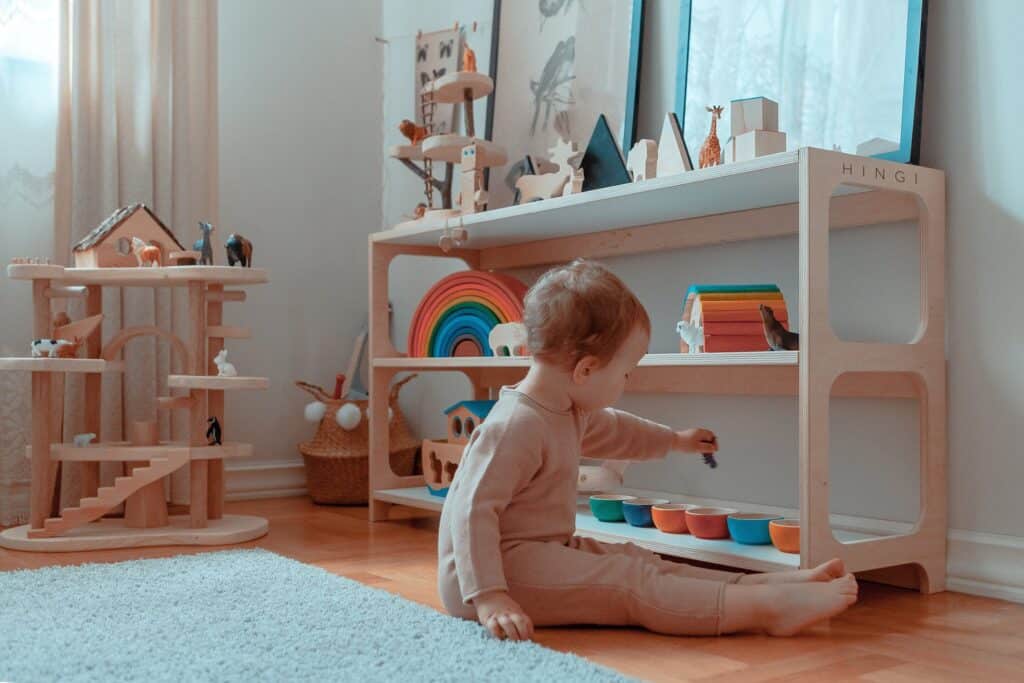
Montessori for Today picks out furniture, educational tools, toys and lifestyle items that we think are the best and most exciting, based on independent research and careful consideration. On some occasions we earn revenue (at no additional cost to you) if you click the links and buy the products. But this doesn’t affect what we choose to highlight and we will never let it bias our coverage. Further information can be found in our Affiliate Disclosure Page.
Don’t:
- Spend all your time cleaning up after your child! The
Montessori balance is one of autonomy and responsibility. “Child-centered” doesn’t mean that adults are waiting on their children hand and foot. A child-centered environment is a space that children take ownership over. This means that they should feel free to move through the space as they please and make choices about what they do, but it also means that they are responsible for keeping their playroom clean and organized. If you want some tips on how to teach this, check out our “practical life” article. - Spend a bunch of money on a “themed” room or fun wall murals. Children thrive in simplicity. A simple
Montessori playroom might look boring to you as an adult, but to a child, it’s warm, cozy, welcoming, and safe. Don’t spend a ton of money and hours of your time creating that jungle-themed playroom you saw on Pinterest. Your child will outgrow it in a few months anyways. - Be afraid of open space! While traditional playrooms are often crammed with wall-to-wall activities,
Montessori playrooms are designed to allow children to move freely. That means they should have space to run around and dance and use their bodies without bumping into hard furniture or knocking things over! - Make it about you. This sounds harsh, but we’ve all been in a place where we’re so excited about an idea we have for our child that it’s hard to let it go when it doesn’t play out the way we want in the real world. Maybe you loved Dr. Seuss as a kid and always dreamed of making a Dr. Seuss-themed playroom, but that might not be what’s actually best for your child. As hard as it can be, making the best choice for your child might not be as fun for you.
So, now that you have an idea for what a
How to Set Up a Montessori Playroom in Your Home
As always with this kind of “how-to” section, it’s important to remember that this will look different for everyone. And that’s okay! Not everyone has a spare room in their home, or a room for each child, or a house at all! Many of us aren’t in a position to go to Ikea and buy a new child-sized shelving unit, or invest in a whole bunch of high-quality Montessori toys.
A lot of us don’t even have time in our busy schedules to repaint! That is all completely fine. Remember,
In fact,
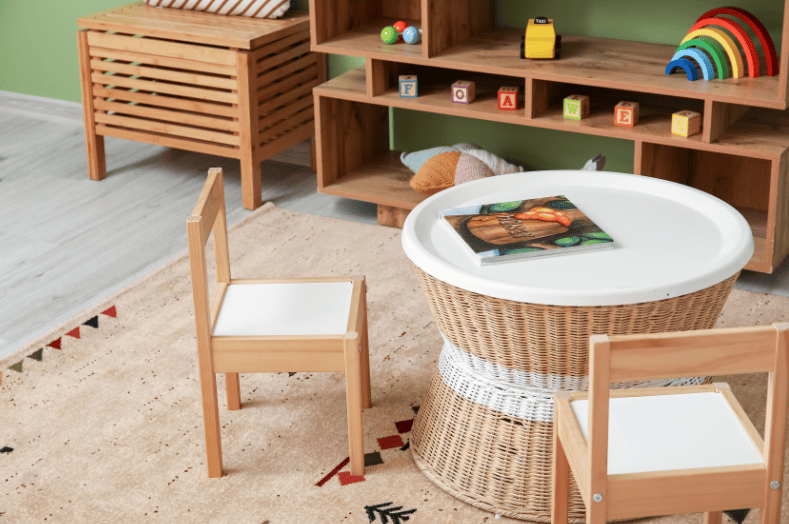
And this is part of what makes
Once you’ve chosen a space, you can start by thinking about how to make it safe, accessible, and inviting for your child. Again, simplicity is key here. Are you in an apartment and you aren’t allowed to repaint those drab, grey walls? It doesn’t matter! Grey is totally okay. No need to repaint it your child’s favorite color. Instead, think about what is within your control. Start with function and then move towards comfort.
So, starting with function, think about how you can make the space child-centered and organized. Do you have shelving that is child-sized? Move it into the space. Don’t have any low shelves? Can you buy some? Are there any available on for cheap or free on places like craigslist or Facebook marketplace? Could you use the bottom levels of some high shelves? If you or someone you know is handy, could you build some? Could you get creative with it? Maybe you can create a grouping of shelves by standing up bins or wooden boxes in a row. You can also get creative with baskets of all types.
No matter what, make sure that your child can reach any shelf or area they might need and that everything is safely secured so that it doesn’t pose a safety hazard. Remember, if a kid can grab it, they can pull it, and you don’t want them pulling a heavy shelf down on themselves.
Now, think about what else you want to include in this space. If you have floor toys like a pikler triangle or climber, find a space for them where children can use them safely. Think about where you can set up furniture and places for your child can sit, lie down, or hide. If you don’t have child-sized furniture and can’t afford to get any right now, think about using pillows, carpets, blankets, and beanbag chairs! It can be good to have a flat surface like a tabletop or an empty set of shelves for children to use as well.
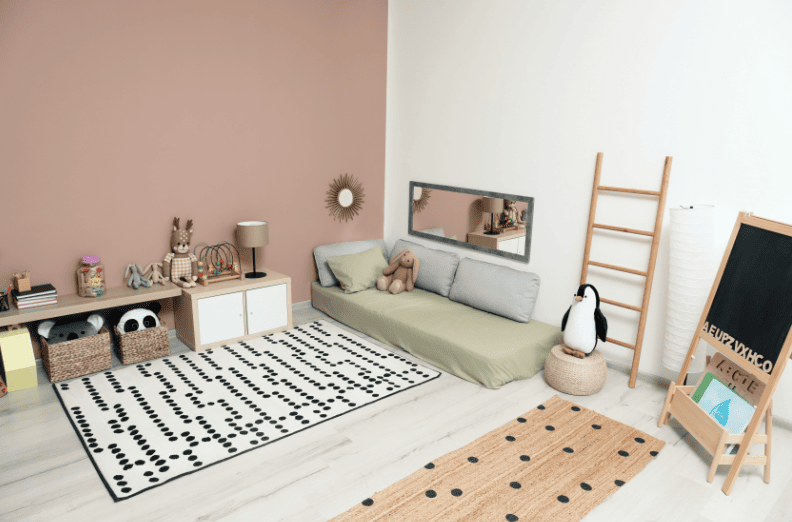
Once you get your basic environment set up, you can move onto toys, books, and activities. As mentioned before, the most important things to remember here are to limit choice and to ensure everything has an organized place. Have a space for books, a space for toys, and a space on the floor for larger toys. Make sure that you are choosing books your child can read independently (or at least interact with independently depending on their age) and toys they know how to use. Each toy and book should have a specific spot where it “lives.”
The last part of setting up a
Montessori Playroom Ideas and Inspiration
Now, I know that this whole article has stressed simplicity, but that doesn’t mean that setting up your own
- Ideas for Montessori playrooms in small spaces
- Toddler playroom ideas
- Multi-age Montessori playroom ideas
- Montessori playroom Pinterest boards
- Designing playrooms for disabled children (this one is not
Montessori -specific, but provides some helpful guidance that could be incorporated intoMontessori playrooms.)
Have fun creating your brand new


